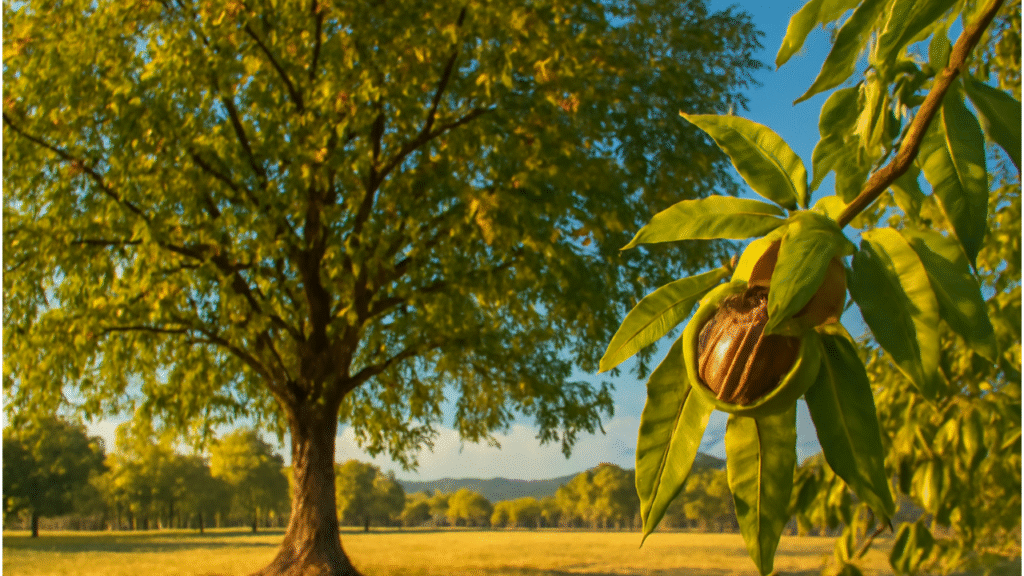
Growing Pecan Tree from Seed: A Step-by-Step Guide to Successfully Planting and Nurturing Your Own Pecan Tree
Table of Contents
Toggle🌳 Understanding Pecan Trees 🌳
Before diving into growing your pecan tree from seed, it’s important to understand what you’re working with. Pecan trees are a long-term investment, so setting the right foundation for their growth is key! In this section, we’ll explore the basics you need to know to set yourself up for success. 🌰🌟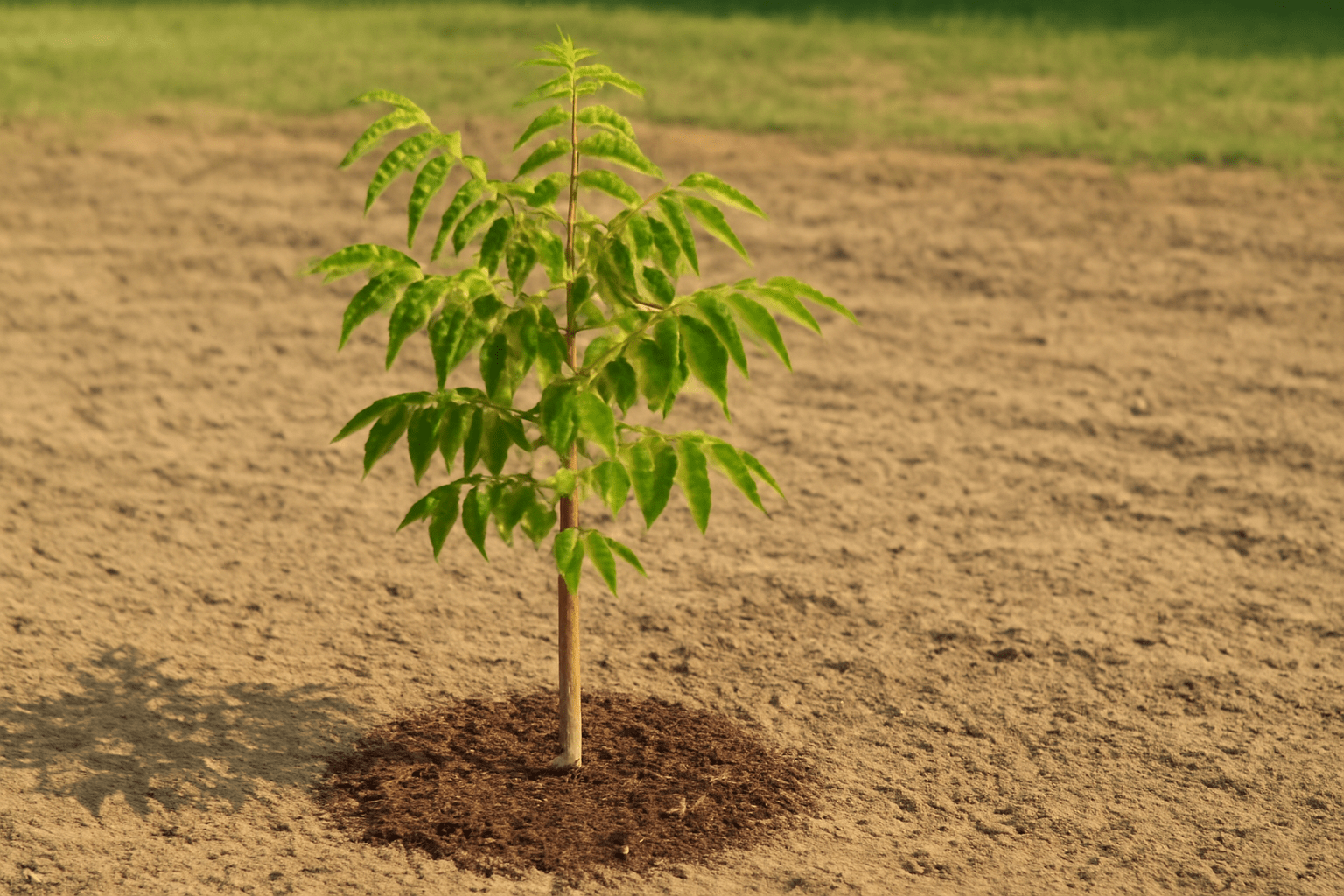
🌱🏡 What Are Pecan Trees? 🏡🌱
Pecan trees (Carya illinoensis) are large, deciduous trees native to North America. Known for their delicious nuts 🍽️ and attractive shade 🌳, they’re a great addition to any yard, especially if you have patience! Growing a pecan tree from seed means you’re starting with a blank canvas, so it’s crucial to give them the proper care from the start. 🌱💚🌞 Growth Habits: 🌞
Pecan trees can grow up to 70 feet tall and spread out just as wide 🌳➡️🌳, so make sure you have plenty of space! They grow well in warm climates 🌞, but can also tolerate mild winters ❄️.🍂 Longevity: 🍂
Pecan trees are long-lived 🌱. In fact, many mature trees can live for over 100 years 🎉, producing delicious pecans along the way. So when you grow one, you’re setting up for a future full of homegrown nuts! 🍂🌰🌍☀️ Ideal Climate for Growing Pecan Trees 🌦️🌱
Pecan trees thrive in USDA Hardiness Zones 6-9, where summers are warm 🌞, and winters are mild ❄️. These trees need long, hot summers to grow their deep roots 🌳💧 and produce nuts.🥶 Best Temperature: 🥶
Pecans prefer temperatures between 75°F and 95°F (24°C to 35°C) 🌡️. Too cold 🥶, and they might struggle to grow 🌱.🌞 Sunlight: 🌞
Full sunlight 🌞 is a must! Your pecan tree will need at least 8 hours of sunlight a day 🌅 to grow strong 💪 and healthy. 🌱🌱🌧️ Soil and Drainage Requirements 💧🌾
To ensure your pecan tree grows well 🌳, you need the right soil 🌾 and drainage 💧.🌾 Soil Type: 🌾
Pecan trees prefer deep, well-draining soil 🌍 that’s slightly acidic to neutral (pH 6.0 to 7.0) 🌿. Loamy soil is ideal because it allows for good root expansion 🌱💧.🌧️ Drainage: 🌧️
Ensure the area you plant in has good drainage 🚰. Standing water 💧 can lead to root rot, which is bad news for your tree 🍂.🌰🌿 What to Expect as Your Pecan Tree Grows 🌳🍂
Pecan trees can take time ⏳ to mature. Growing from seed requires patience 🧘, but it’s worth the wait! Here’s what you can expect over the years 🌳:🌱 Early Growth (Years 1-3): 🌱
In the first few years, your pecan tree will grow slowly 🐢. Focus on watering 💧, mulching 🍂, and keeping it protected from pests 🐛 and diseases 🌿.🍃 Mature Growth (Years 5+): 🍃
Once your tree is established 🌳, it will grow much faster 🚀. It might take around 5-10 years before your pecan tree starts to bear fruit 🥜🍂. While it may take some time ⏳ to harvest your first pecans, the long-term benefits are worth the effort! You’ll soon have your very own source of fresh, homegrown nuts 🌰 that you can use for baking 🍪, snacking 🍩, or gifting 🎁 to others.🌰 How to Collect Pecan Seeds 🌰
Collecting pecan seeds is an exciting step in growing your own tree from scratch! Knowing when and how to gather your seeds ensures you start with the best possible material for planting. Let’s break it down simply, step by step. 😊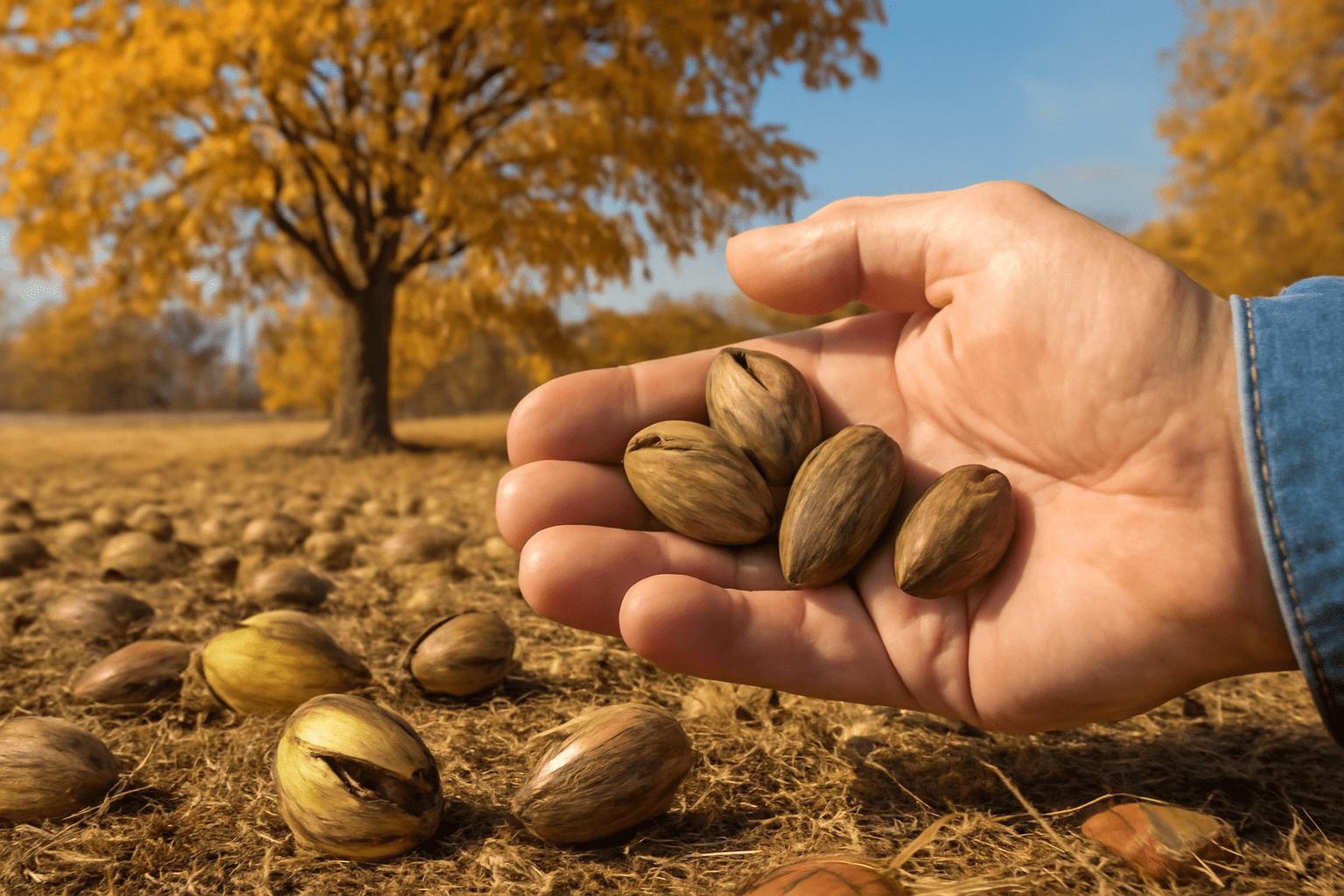
🍂 When to Collect Pecan Seeds 🍂
Timing is crucial when it comes to harvesting pecan seeds. If you wait too long, the seeds may fall to the ground and be lost. If you collect too early, the seeds may not be fully matured.🌾 Best Time for Harvesting 🌾
The ideal time to collect pecan seeds is in late fall, typically from September to November, depending on your climate. The nuts will have fallen from the tree and started to split open naturally. 🌾🌳 Signs Your Pecans Are Ready 🌳
Look for these signs:- The husk (outer shell) starts to split open.
- The nuts will fall from the tree when they’re fully mature.
- The color of the nut will change from green to a more brownish hue as it ripens. 🌳
🌰 How to Collect Pecan Seeds 🌰
Once you see the signs of ripeness, it’s time to start collecting your pecans. Here’s how to do it correctly:🌿 Pick up the Nuts 🌿
Go out to the area where your pecan tree has dropped its nuts. Gently collect them from the ground. If the nuts are still in their husks, you can remove them by hand. Be careful not to damage the seeds inside. 🌿🌟 Check for Quality 🌟
Inspect the nuts you collect. Choose only the healthy, undamaged ones. Avoid nuts with holes or cracks as they may not germinate successfully. 🌟💧 Clean the Seeds 💧
After collecting your pecans, wash off any dirt or debris. This will help prevent mold or rot during the stratification process. 💧🌱 How to Prepare Pecan Seeds for Planting 🌱
After collecting your seeds, it’s important to prepare them before planting. This is where the magic happens, ensuring your seeds have the best chance to grow into healthy trees.❄️ Cold Stratification ❄️
Pecan seeds need cold treatment, also known as stratification, to break dormancy and improve germination. Place your cleaned pecans in a moist paper towel or sand and store them in the fridge for about 60-90 days. This mimics the winter conditions they would experience naturally in the wild. ❄️🌿 Check Periodically 🌿
During stratification, check your seeds regularly for mold or rot. Discard any seeds that show signs of spoilage. Keep the seeds moist, but not soaked, to avoid drowning them. 🌿 By following these simple steps, you can ensure your pecan seeds are ready for planting! 🌳 In the next section, we’ll dive into how to prepare your seeds for the soil and increase your chances of a successful germination. 🌱🌱🌱 Preparing Pecan Seeds for Planting 🌱🌱
Once you’ve collected your pecan seeds and they’ve undergone stratification, it’s time to prepare them for planting. This step is crucial to ensure your seeds have the best chance of germinating and growing into healthy trees. Let’s walk through the process! 😊❄️❄️ Why Stratification Is Important ❄️❄️
Pecan seeds need a period of cold to break dormancy and trigger the germination process. This is why cold stratification is so important. It mimics the natural winter conditions that pecan seeds would experience in the wild, helping them get ready for spring growth.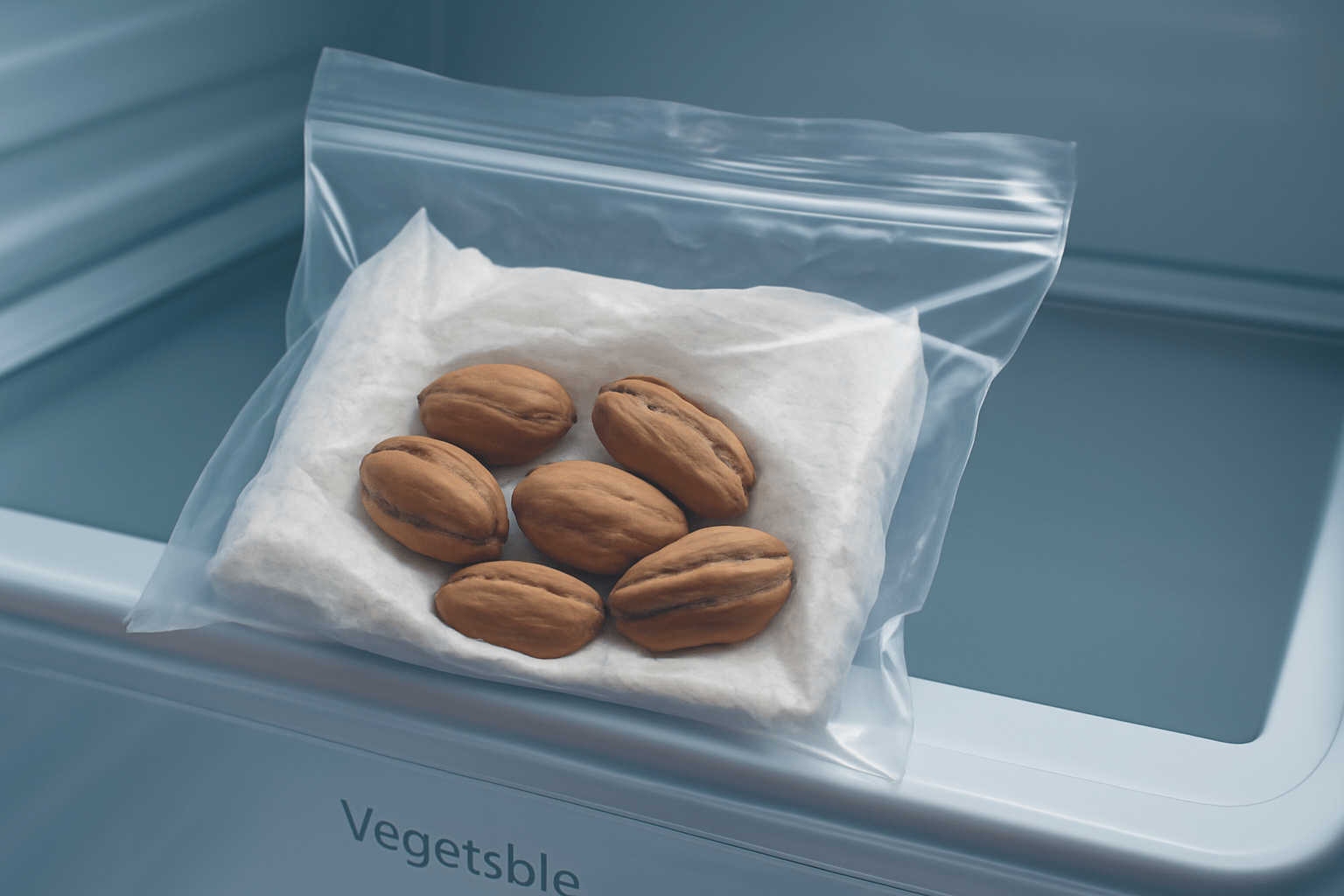
❄️ Cold Stratification: ❄️
After collecting your seeds and cleaning them, the next step is to store them in a moist, cool environment (like a fridge). This process should last for about 60-90 days to ensure the seeds are properly prepared. Pro tip: Keep your seeds in a damp paper towel or a bag of moist sand to maintain the right level of moisture. 🌿🌡️ Temperature: 🌡️
Aim for a temperature of around 34°F to 41°F (1°C to 5°C) while stratifying. Keep the seeds in your fridge’s vegetable drawer for the best results. 🧊🪶🪶 Scarification: Breaking the Seed Coat 🪶🪶
Pecan seeds have a tough outer shell, and in order to encourage successful germination, this shell needs to be scarified, or slightly damaged. This allows moisture to penetrate the seed and kick-start the growth process. 🌱🔨 Scarification Techniques: 🔨
You can scarify your pecan seeds using a few simple methods:- Sandpaper Method: Lightly rub the seed coat with coarse sandpaper, taking care not to damage the seed inside.
- Nail Clippers or Files: Gently nick the seed coat with a pair of nail clippers or a metal file, creating a small scratch or opening.
- Cold-Water Soak: If you’re worried about using abrasive methods, you can also soak the seeds in cold water for 24-48 hours to help soften the shell. 💧
✨ Be Gentle: ✨
The goal is to break the seed coat just enough to let moisture in. Don’t overdo it; a light scratch or nick is all you need. ✨🌿🌿 Preparing the Planting Environment 🌿🌿
Before planting, ensure the soil and environment are ready to receive your pecan seeds. Pecan trees thrive in certain conditions, so setting up the right planting site is crucial for their success.🌱 Soil Type: 🌱
Pecan seeds require well-drained, loamy soil with a slightly acidic to neutral pH (around 6.0 to 7.0). If your soil is heavy or clayey, you can amend it by adding compost or organic matter to improve drainage and fertility. 🌱🌞 Planting Location: 🌞
Pecan trees love full sunlight, so choose a location that receives at least 8 hours of sunlight daily. The spot should also be spacious enough to accommodate the tree’s future growth. 🌞💧💧 Pre-Planting Watering 💧💧
Before you plant your pecan seeds, ensure that the soil is moist but not soggy. Water the area thoroughly before planting to create a moist environment that will help the seeds settle in and start germinating right away. 🌧️ With your pecan seeds prepared and the planting environment ready, you’re now all set for the next step—actually planting your seeds! 🌳 In the next section, we’ll guide you through the process of planting and ensuring your seeds have the best chance to thrive. 🌱🌍🌍 Choosing the Right Soil and Location 🌍🌍
Selecting the ideal soil and location is essential for the successful growth of your pecan tree. The right environment will help your tree develop strong roots, thrive in all seasons, and eventually produce healthy, delicious pecans. Let’s break down the key factors to consider when choosing the perfect spot to plant your pecan seeds! 🌱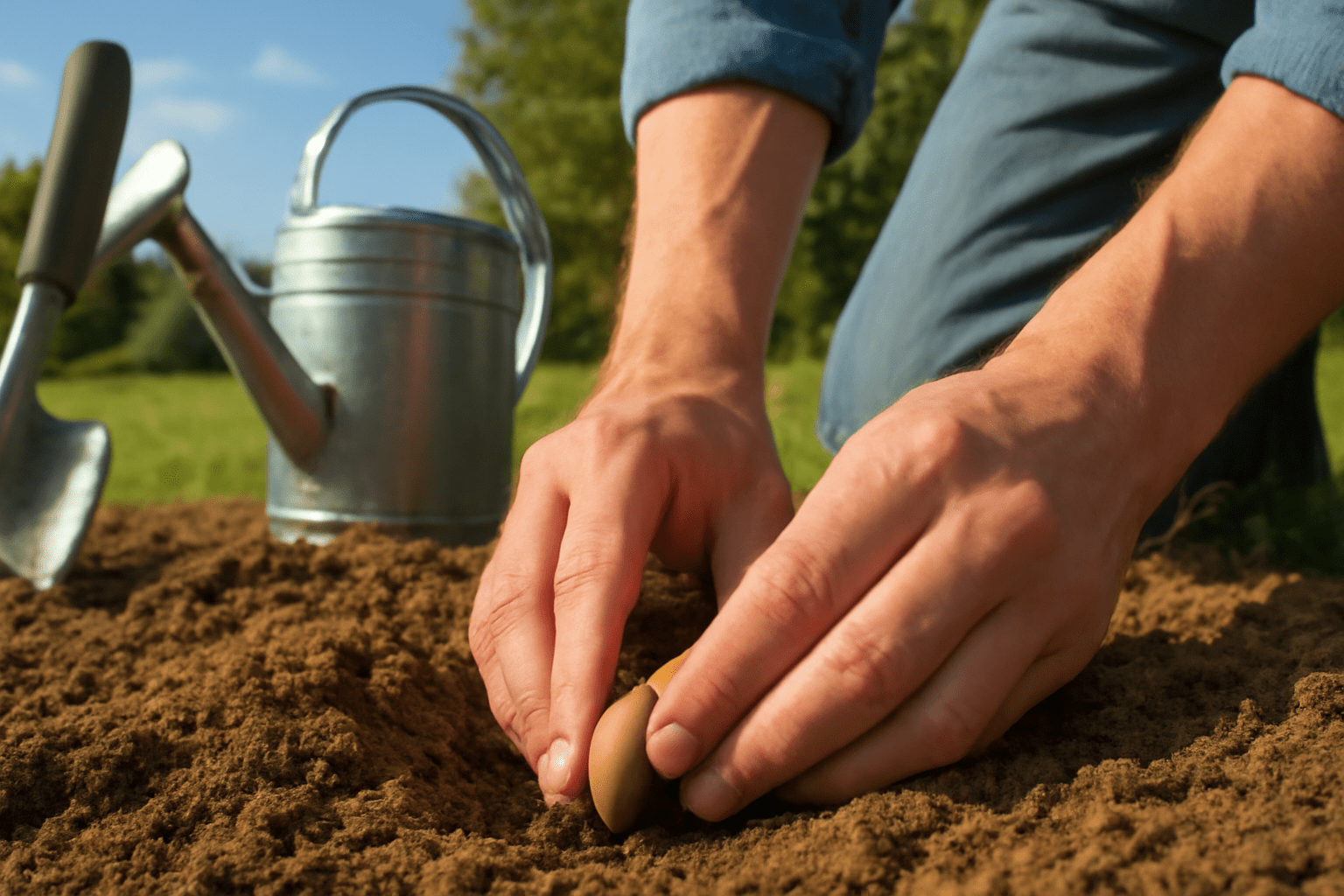
🌞🌞 Choosing the Right Location 🌞🌞
Pecan trees are sun-lovers, and choosing the right spot for planting is crucial. They need lots of light and space to grow properly.🌞 Full Sunlight: 🌞
Pecan trees need at least 8 hours of direct sunlight per day to grow strong and healthy. Ensure that the location you choose is free from heavy shade, especially during the afternoon. The more sunlight, the better the growth! 🌞🌳 Spacing: 🌳
Keep in mind that pecan trees can grow quite large—up to 70 feet tall and wide! So, when selecting a planting site, make sure there’s enough room for the tree to spread out as it matures. A minimum distance of 40-50 feet from other trees, structures, or buildings is recommended. 🌳🌬️ Wind Protection: 🌬️
While pecan trees are hardy, they don’t like strong winds. If your chosen location is exposed to wind, consider planting in a spot where the tree will have some natural windbreaks, like nearby fences or larger trees. 🌬️🌾🌾 Soil Type: The Foundation for Healthy Growth 🌾🌾
Pecan trees are picky when it comes to soil, so it’s important to create the right conditions before planting.🌧️ Well-Draining Soil: 🌧️
Pecan trees thrive in well-draining, loamy soil. They don’t like “wet feet” (roots that are constantly soaked in water), so avoid areas that tend to stay soggy. If the soil is too clayey, it can trap water, leading to root rot. 🌧️🧪 Soil pH: 🧪
The soil should be slightly acidic to neutral, with a pH level between 6.0 and 7.0. If your soil is too acidic or alkaline, you can amend it with soil conditioners like lime (to raise pH) or sulfur (to lower pH). 🧪🌿 Soil Depth: 🌿
Pecan trees need deep soil to establish strong roots. Aim for soil that’s at least 3 feet deep—the deeper the better. If your soil is shallow, consider planting in raised beds or improving soil depth with compost. 🌿🌾 Soil Amendments: 🌾
If your soil is heavy or clay-like, add organic matter such as compost or peat moss to improve drainage and fertility. This will help the roots spread out easily and access the nutrients they need. 🌾💧💧 Watering Considerations 💧💧
Before you plant, ensure that the chosen spot will allow for consistent watering. While pecan trees need regular moisture to establish their roots, they don’t like standing water.💦 Watering Needs: 💦
Newly planted pecan seeds need regular watering, especially during dry spells. However, make sure that the soil drains well enough to prevent water from pooling around the roots. Overwatering can lead to root rot, so always check that the soil is moist, not soggy. 💦🌊 Avoid Low-Lying Areas: 🌊
Stay away from areas prone to flooding or waterlogging. Choose a raised or slightly elevated spot where water won’t accumulate and drown your young tree. 🌊 With the right soil and location, your pecan tree will have the foundation it needs to grow strong and healthy. 🌳 In the next section, we’ll dive into how to plant your pecan seed properly and set your tree on the path to success! 🌱🌱 Section 5: Planting Your Pecan Seed 🌱
Now that you’ve prepared your pecan seed and chosen the perfect soil and location, it’s time to plant it! This step is all about setting the seed up for success by giving it the best environment to grow strong roots and healthy growth. Let’s walk through the planting process, step-by-step. 😊🕰️ Best Time to Plant Your Pecan Seed 🕰️
Timing is key when it comes to planting your pecan seed. The best time to plant is during early spring or fall when temperatures are moderate, and the soil is moist but not too wet.- Spring Planting: Early spring, after the last frost, is ideal because the warmer temperatures will help the seed germinate.
- Fall Planting: If you’re planting in fall, do so a few weeks before the first frost so the seed has time to establish its roots before winter.
🌳 How to Plant Your Pecan Seed 🌳
Now that you’ve chosen the right time and spot, here’s how to plant your pecan seed:- Dig the Hole:
- Use a garden shovel to dig a hole that’s about 3-4 inches deep. You want the seed to be planted at the right depth to protect it from the elements and encourage strong root growth.
- If you’re planting multiple seeds, make sure to space them 6-8 feet apart. This will give each tree enough room to grow without competing for resources. 🌍
- Prepare the Seed:
- Take the stratified and scarified pecan seed and gently place it in the hole, with the pointed end facing down. This is the side where the root will emerge.
- If the seed has a thin or damaged shell, be careful not to plant it upside down, as this could affect germination. 🌱
- Cover the Seed:
- Once the seed is in place, gently cover it with soil. Make sure to pat down the soil lightly to remove air pockets and ensure good seed-to-soil contact. 🌿
- Avoid packing the soil too tightly, as it can make it harder for the seedling to push through the surface when it starts growing.
- Water Thoroughly:
- After planting, water the area thoroughly to settle the soil around the seed. The soil should be moist but not soggy. This initial watering will help create the ideal environment for your seed to begin germinating. 💧
🌾 Caring for the Seed After Planting 🌾
Once your pecan seed is planted, the care doesn’t stop there! You need to monitor its progress and provide a bit of attention during the germination phase.- Watering: Keep the soil consistently moist, especially if you’re planting during warmer months. Ensure the soil doesn’t dry out completely, but be careful not to overwater, as that can cause the seed to rot. 💦
- Mulch: Add a layer of mulch around the base of the seedling. This will help retain moisture, keep the soil temperature stable, and prevent weeds from growing. Organic mulch, like wood chips or straw, works best. 🌾
- Protection: During the first few weeks, protect the seed from animals and pests. Use wire mesh or a small fence around the area to prevent critters from digging up the seed. 🦔
🌻 What to Expect After Planting 🌻
After planting, the waiting game begins! It can take 2-4 weeks for your pecan seed to sprout. During this time, it’s important to be patient and give the seed enough time to break through the soil.- Germination Process: As the seed absorbs moisture, it will begin to sprout and send out its first tiny root. After a few weeks, you’ll see the seedling’s stem push up from the soil, followed by the first leaves. 🌿
- Monitoring Growth: Once the seedling starts to emerge, continue watering regularly. If you planted during fall, it may lie dormant through the winter and resume growth in the spring. 🌱
🌱🌱 Caring for Your Pecan Seedling 🌱🌱
Congratulations! Your pecan seedling has begun to grow, and now it’s time to give it the care it needs to thrive. Caring for a young pecan tree requires attention, but with the right approach, you’ll help your seedling grow strong and healthy. Let’s explore the best practices for nurturing your pecan seedling! 🌿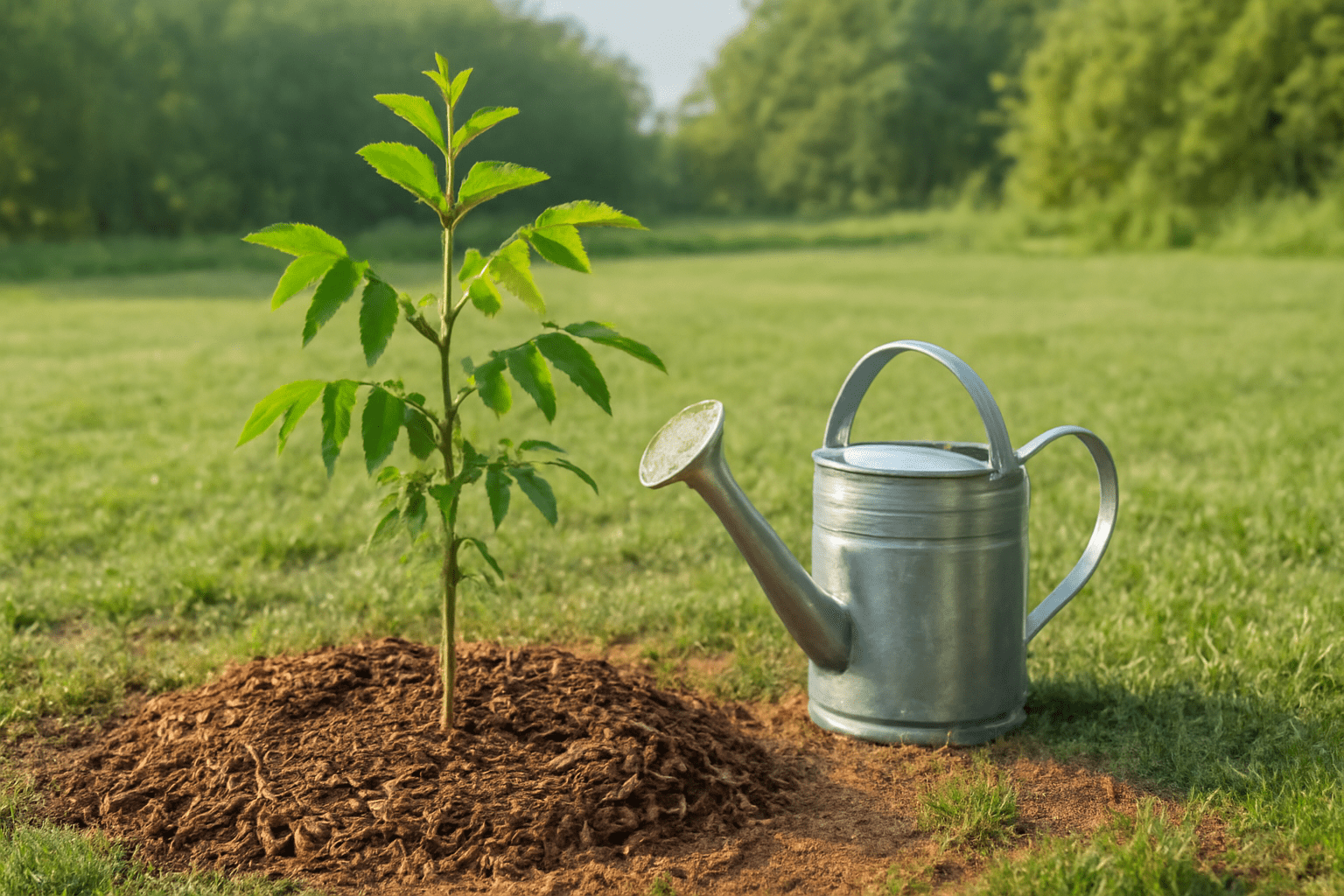
💧💧 Watering Your Pecan Seedling 💧💧
Watering is one of the most important factors in ensuring your seedling grows strong roots and stays healthy.🌊 Initial Watering: 🌊
After planting, keep the soil moist but not waterlogged. Water the seedling regularly, especially if the weather is warm or dry. Deep watering is key, as it encourages the seedling to develop deep roots. 🌊💦 Regular Watering: 💦
Once the seedling has emerged, aim to water it at least once a week (or more frequently if the weather is hot). Ensure that the soil remains moist but never soggy.🚫 Avoid Overwatering: 🚫
While water is important, too much water can lead to root rot. Check the soil regularly by sticking your finger into the ground—if it feels damp an inch below the surface, it’s time to water. 💦🌞🌞 Sunlight Requirements 🌞🌞
Pecan trees love the sun! A young pecan seedling requires at least 8 hours of direct sunlight each day to grow strong. Here’s how you can ensure your seedling gets the sunlight it needs:🌅 Full Sun: 🌅
Ensure that your seedling is planted in a location where it gets plenty of sunlight. Avoid areas that are too shady, as this will stunt its growth. 🌅🌻 Moveable Planters: 🌻
If your seedling is in a pot, you can move it around to find the sunniest spot in your garden or yard. 🌻🌿🌿 Mulching Around Your Pecan Seedling 🌿🌿
Mulching is a simple but effective way to keep your seedling healthy by preserving moisture, improving soil quality, and reducing weeds.🌾 Apply Organic Mulch: 🌾
Spread a 2-3 inch layer of organic mulch around the base of the seedling. This can be made of wood chips, straw, or leaves. Mulch helps to:- Retain moisture in the soil.
- Keep the soil temperature stable.
- Prevent weeds from competing with your seedling for nutrients. 🌾
🌿 Keep Mulch Away from the Trunk: 🌿
Be sure to leave a small gap between the mulch and the trunk to prevent moisture buildup that could cause rot. 🌿🦟🦟 Protecting Your Seedling from Pests and Diseases 🦟🦟
Young seedlings are vulnerable to pests and diseases, so regular monitoring is essential to keep them healthy.🐜 Pests to Watch For: 🐜
- Aphids: Small, sap-sucking insects that can stunt growth. If you spot them, remove them by spraying the seedling with water or applying organic insecticidal soap. 🧼
- Fungus Gnats: These tiny flying insects can damage roots. Use sticky traps to catch the adults and ensure the soil doesn’t stay too wet.
- Mice and Rabbits: If your seedling is at risk of being eaten by rodents, consider installing a small fence or using a protective barrier around the tree. 🦔
🌧️ Diseases to Monitor: 🌧️
Keep an eye out for symptoms of diseases like powdery mildew or root rot. If you notice yellowing leaves, wilting, or white powder on leaves, treat with organic fungicides and make sure your seedling is not waterlogged. 🌧️🌳🌳 Pruning and Shaping Your Seedling 🌳🌳
Pruning helps your seedling develop a strong structure and a healthy shape. While young, it’s important to focus on shaping the tree and removing any damaged or competing branches.✂️ Pruning Tips: ✂️
- Remove any dead, damaged, or diseased branches as soon as you notice them. 🌿
- If you’re growing your pecan seedling in a container, prune the top to encourage lateral growth.
- Prune in the early spring before new growth begins to avoid stressing the tree. ✂️
🌾🌾 Fertilizing Your Seedling 🌾🌾
Fertilizing gives your seedling the nutrients it needs to grow strong and healthy. However, be careful not to over-fertilize, as this can harm the tree.🌱 When to Fertilize: 🌱
Start fertilizing your pecan seedling in spring once new growth begins.🌿 How to Fertilize: 🌿
- Apply the fertilizer around the base of the seedling, following the instructions on the package.
- Water the tree thoroughly after fertilizing to help the nutrients soak into the soil.
🏡🏡 Protecting Your Seedling During Winter ❄️❄️
If you’re growing your pecan seedling in an area that experiences cold winters, take steps to protect it from frost and freezing temperatures.❄️ Mulch for Winter Protection: ❄️
Apply an additional layer of mulch around the base of your tree to protect the roots from freezing.🌬️ Covering the Seedling: 🌬️
In extremely cold climates, consider covering your seedling with a protective tree guard or burlap to shield it from freezing winds and frost. 🌬️ By following these simple yet effective care practices, your pecan seedling will grow strong and healthy, ready to become a mature tree in just a few years! 🌳 In the next section, we’ll discuss how to troubleshoot common issues and keep your tree thriving as it matures. 🌱🛠️🛠️ Troubleshooting Common Pecan Tree Problems 🛠️🛠️
Even with the best care, your pecan tree may face a few challenges along the way. Don’t worry! Identifying and addressing these issues early will help keep your tree healthy and thriving. In this section, we’ll cover some common problems you might encounter while growing your pecan tree, and how to solve them effectively. 🌿🍂🍂 1. Yellowing Leaves (Chlorosis) 🍂🍂
Yellowing leaves are one of the most common issues with pecan trees. If the leaves start turning yellow, it could be a sign that your tree is stressed.🌿 Possible Causes: 🌿
- Nutrient Deficiency: A lack of essential nutrients like nitrogen, iron, or manganese can cause yellowing leaves. 🌿
- Overwatering or Poor Drainage: If the soil is too wet, the roots can become waterlogged, leading to yellowing leaves.
- Pests or Diseases: Some pests, like aphids, or diseases like powdery mildew, can also cause yellowing.
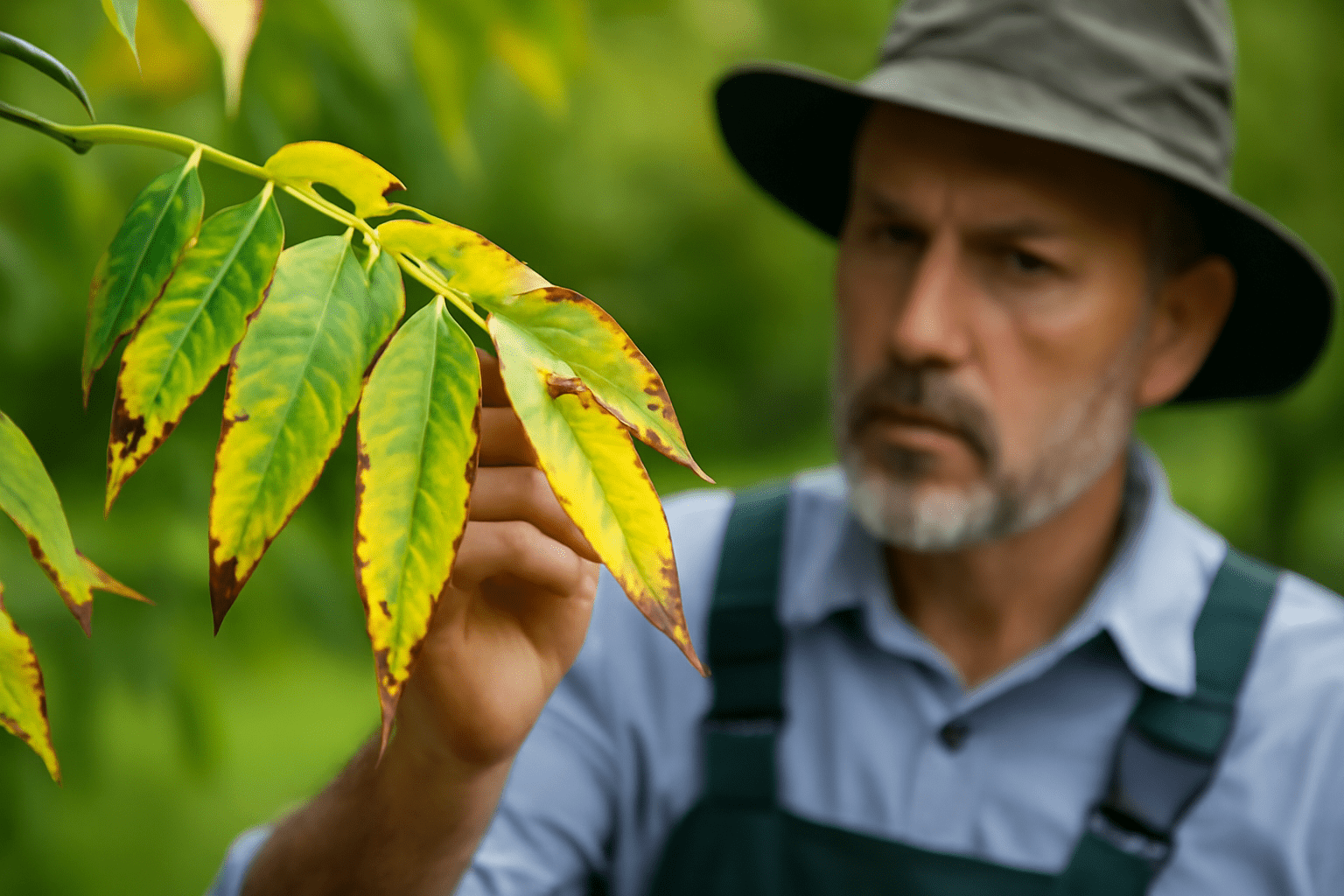
✅ Solutions: ✅
- Fertilize Your Tree: Use a balanced fertilizer with micronutrients, especially nitrogen and iron, to correct deficiencies.
- Check Soil Drainage: Ensure that the soil drains well and is not waterlogged. Consider adding organic matter to improve drainage.
- Monitor for Pests/Diseases: Check the underside of leaves for pests like aphids or signs of fungal infections. Treat with organic pesticides or fungicides if necessary. 🦟
🐜🐜 2. Pests: Aphids and Weevils 🐜🐜
Pecan trees are susceptible to pests like pecan weevils and aphids, which can damage leaves and nuts. Aphids, in particular, can also introduce harmful diseases to your tree.🍃 Aphids: 🍃
- These tiny insects feed on the sap of your tree, causing leaves to curl and weaken.
✅ Solution: ✅
- Spray your tree with water or organic insecticidal soap to remove aphids. You can also introduce natural predators like ladybugs to help control their numbers. 🐞
🌰 Pecan Weevils: 🌰
- Pecan weevils are known to attack nuts, making them inedible. The larvae burrow into the nuts, causing them to fall prematurely.
✅ Solution: ✅
- Regularly inspect nuts for damage.
- Use insecticides designed for pecan weevils during the growing season to reduce their numbers.
- Consider setting up traps to monitor the weevil population.
🌧️🌧️ 3. Root Rot 🌧️🌧️
Root rot is a common problem for pecan trees, especially if the soil is poorly drained or if the tree has been overwatered. This condition can kill your tree if not addressed.🍂 Symptoms: 🍂
- Yellowing or wilting leaves despite regular watering.
- Soft, mushy roots when you dig around the base of the tree.
✅ Solution: ✅
- Improve Drainage: Ensure your soil has proper drainage. If your soil is heavy and clayey, amend it with organic matter to improve flow.
- Water Carefully: Avoid overwatering your tree. Ensure the soil is moist but not soaked.
- Remove Affected Roots: If you suspect root rot, carefully remove the affected roots with a clean, sharp tool, and let the tree dry out before watering again.
🌬️🌬️ 4. Wind Damage 🌬️🌬️
Pecan trees are tall and have wide canopies, making them susceptible to wind damage, especially in young trees or during storms.🍃 Symptoms: 🍃
- Broken branches or torn leaves.
- The tree may lean to one side if it’s been pushed by strong winds.
✅ Solution: ✅
- Provide Wind Protection: If your pecan tree is in a windy area, consider planting a windbreak of other trees or erecting a temporary fence to shield it from strong gusts. 🌲
- Staking Young Trees: Young pecan trees can be staked to prevent them from leaning during strong winds. Use soft ties to avoid damaging the tree. 🏗️
🐛🐛 5. Leaf Curl and Powdery Mildew 🐛🐛
Powdery mildew is a fungal infection that can cause your tree’s leaves to curl and develop a white, powdery coating. It’s common during humid or wet weather.🍂 Symptoms: 🍂
- White, powdery spots on leaves, especially on the undersides.
- Leaves may curl and turn yellow.
✅ Solution: ✅
- Prune Affected Leaves: Remove any infected leaves to stop the spread of the fungus. ✂️
- Improve Airflow: Ensure your tree has good air circulation around it to prevent moisture buildup.
- Use Fungicides: Apply an organic fungicide, such as neem oil, to control powdery mildew. 🌿
🔥🔥 6. Sunburn or Scalding 🔥🔥
Young pecan trees are sensitive to intense sunlight, especially during the hottest parts of the year. Sunburn can cause damage to the leaves, leading to scalding and leaf drop.🍂 Symptoms: 🍂
- Brown, dry spots on the leaves.
- Leaves may appear scorched or burned at the tips.
✅ Solution: ✅
- Provide Shade: If your tree is young, consider providing temporary shade during the hottest part of the day, especially in the first few years. You can use shade cloth or a simple garden canopy. 🌳
- Water Properly: Ensure your tree is well-hydrated, as dry conditions can increase the risk of sunburn.
🌟🌟 Preventive Measures for Long-Term Health 🌟🌟
While troubleshooting is important, preventing issues from arising in the first place is even better! Here are a few general tips to keep your pecan tree healthy and thriving for years to come:- Monitor Regularly: Check your tree for pests, diseases, and signs of stress. Early detection is key! 🧐
- Fertilize Annually: Use a balanced fertilizer each spring to ensure your tree has the nutrients it needs. 🌿
- Proper Watering: Avoid overwatering and ensure that your tree has good drainage. 💧
- Prune Correctly: Regularly prune to remove dead or damaged branches and promote healthy growth. ✂️
🌳🌳 Growing a Pecan Tree into Maturity 🌳🌳
Growing a pecan tree from seed is a long-term commitment, but the reward is a tree that can live for over 100 years, providing you with delicious nuts and beautiful shade. As your tree matures, it will require different care and attention to help it grow strong, healthy, and eventually produce its first harvest. Let’s explore how to care for your pecan tree as it transitions from a seedling to a mature tree. 🌱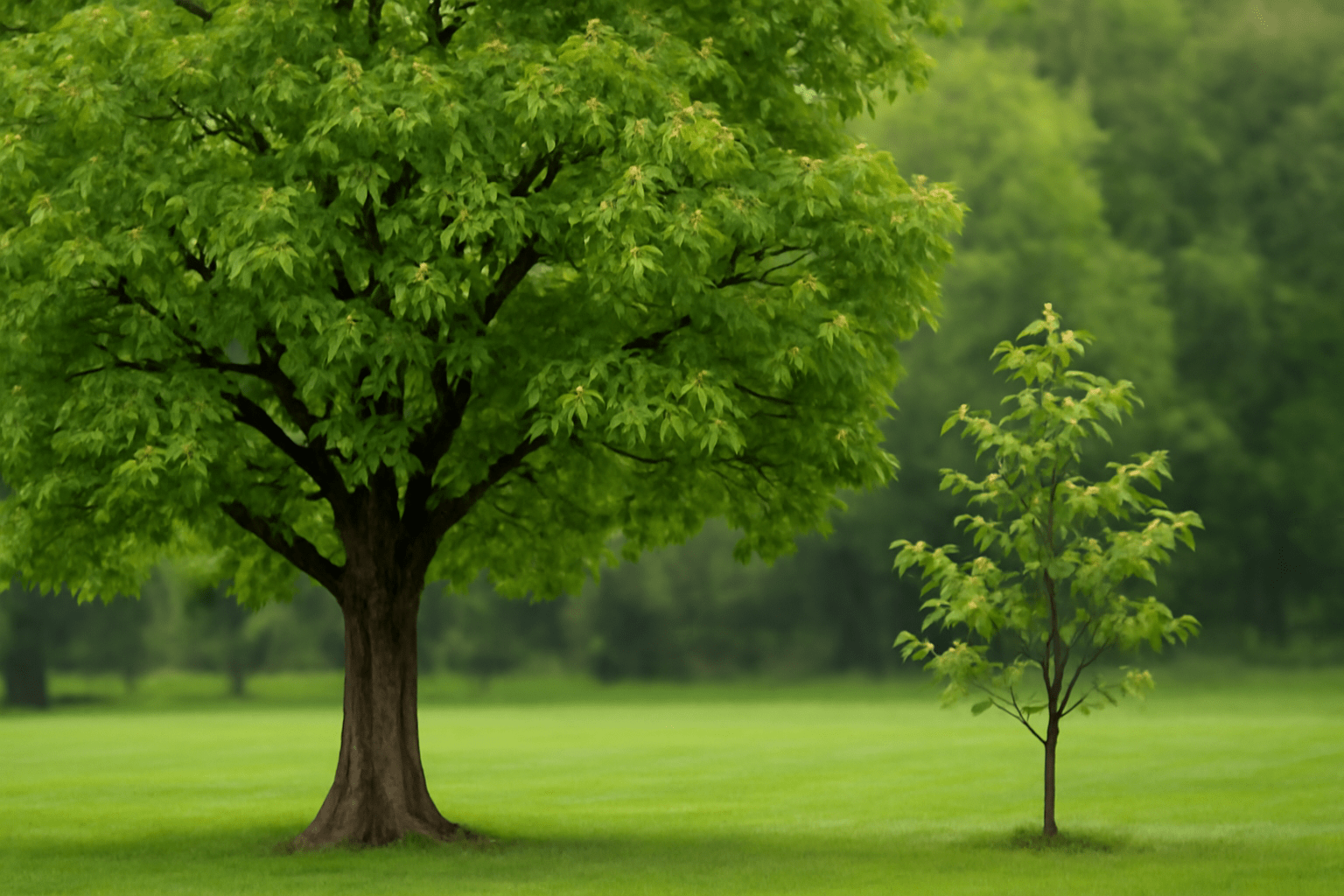
⏳⏳ The Growth Timeline: What to Expect ⏳⏳
Pecan trees take time to mature, and while you may not see nuts right away, the journey from seed to fruit-bearing tree is incredibly rewarding. Here’s a breakdown of the general timeline:🌿 Years 1-3 (Seedling Phase) 🌿
During these early years, the tree is focused on root development and establishing a strong trunk. At this stage, it will grow slowly but steadily, so be patient and provide consistent care. 🌿🌳 Years 4-7 (Juvenile Phase) 🌳
Your tree will start to grow more rapidly, developing larger branches and a fuller canopy. During this time, continue to water, mulch, and prune it to encourage strong growth. 🌳🌰 Years 8-10 (Mature Phase) 🌰
Around the 8-10 year mark, your pecan tree will begin to show signs of maturity, and it may start to flower. However, it typically takes 10-12 years for a pecan tree to bear its first crop of nuts. 🌰🌳 Years 15+ (Full Maturity) 🌳
By now, your tree will be producing a reliable crop of pecans, and its growth will have slowed. At this point, it’s important to maintain care to ensure continued productivity for years to come. 🌳🌞🌞 Ensuring Your Tree Gets the Right Care 🌞🌞
As your pecan tree matures, you’ll need to make some adjustments to your care routine to support its growth and eventual fruit production.🌞 Sunlight 🌞
Pecan trees need full sunlight to thrive, even as they grow older. Ensure that your tree continues to receive at least 8 hours of direct sunlight daily. 🌞💧 Watering Needs 💧
Once established, mature pecan trees are somewhat drought-tolerant. However, they still need consistent watering during dry spells. Aim to water deeply once or twice a week during hot, dry months, especially in the first few years of fruiting. 💧🌾 Fertilizing for Growth 🌾
Fertilize your tree annually with a balanced fertilizer to encourage continued growth and nut production. Apply fertilizer in early spring, just before the new growth begins. Use a slow-release fertilizer that provides a steady supply of nutrients throughout the growing season. 🌾✂️✂️ Pruning to Promote Strong Growth ✂️✂️
Pruning is an important part of maintaining a healthy pecan tree as it matures. Proper pruning encourages strong branching, better airflow, and improved nut production.🍂 When to Prune 🍂
Prune your tree during the winter dormancy period (late fall to early spring) when the tree is not actively growing. This reduces stress on the tree and prevents spreading diseases.✂️ How to Prune ✂️
- Remove Dead or Damaged Wood: Prune any branches that are dead, diseased, or broken to improve the tree’s structure.
- Thin Out the Canopy: If the tree has a dense canopy, thin out some of the inner branches to increase airflow and sunlight penetration. This helps prevent fungal diseases and promotes better nut production.
- Shape the Tree: For young trees, prune to maintain a strong central leader and well-spaced branches. Avoid removing more than 25% of the tree’s canopy in one year.
🌰🌰 Encouraging Nut Production 🌰🌰
One of the most exciting milestones in growing a pecan tree is when it starts to produce nuts! However, pecan trees require specific conditions to set fruit.🌬️ Pollination 🌬️
Pecan trees are wind-pollinated, and they typically need at least one other pecan tree nearby to cross-pollinate and produce nuts. Make sure to plant multiple trees if you want a successful harvest. 🌬️🌸 Flowering 🌸
Pecan trees usually start flowering in the spring, and the flowers are catkins that release pollen. The tree needs to be well-established and in good health to produce flowers.🌰 Fruiting 🌰
After pollination, the pecans will begin to develop. It takes 5-6 months for the nuts to mature, typically reaching harvest time in fall (September to November).🌰 Harvesting 🌰
Pecans are ready for harvest when the husks start to split open and fall to the ground. Gently shake the tree to collect the fallen nuts, and then remove the husks. 🌰🐦🐦 Dealing with Wildlife and Pests 🐦🐦
As your pecan tree matures and starts producing nuts, you may attract wildlife looking for a snack! Here’s how to protect your harvest:🐿️ Squirrels and Rodents 🐿️
Squirrels and other small animals love pecans, so consider using protective netting or tree guards to keep them from accessing your nuts. You can also install squirrel baffles around the trunk to prevent them from climbing the tree. 🐿️🍃 Pests 🍃
In addition to aphids and pecan weevils, mature trees may face other pest problems. Regularly inspect your tree and use organic insecticides when necessary. 🍃🌳🌳 Maintaining Your Tree for Longevity 🌳🌳
Pecan trees can live for over 100 years, so taking care of them as they mature is crucial for their long-term health.🌿 Check for Disease 🌿
Regularly inspect your tree for signs of disease or pest infestations. The earlier you spot problems, the easier they are to manage. 🌿🌬️ Protect Against Storms 🌬️
Mature pecan trees have large canopies that can be vulnerable to wind damage. If you live in a storm-prone area, make sure to provide wind protection and keep your tree well-pruned to minimize the risk of damage. 🌬️🌾 Mulching and Watering 🌾
Continue to mulch around the base of the tree to retain moisture and maintain soil health. Water deeply during dry periods, especially in the summer months. 🌾 By following these practices, your pecan tree will continue to grow strong and healthy, providing you with delicious, homegrown nuts for years to come. 🌰 Patience is key when growing a pecan tree from seed, but the reward is worth the wait! In the next section, we’ll wrap up with some final thoughts on growing your pecan tree successfully. 🌳🌳🌳 Final Thoughts on Growing and Caring for Pecan Trees 🌳🌳
Growing a pecan tree from seed is a rewarding journey that requires patience, dedication, and attention to detail. From selecting the right seeds to nurturing your young tree into a mature, fruit-bearing powerhouse, every step brings you closer to enjoying the fruits of your labor—literally! 🌰🌱🌱 Key Takeaways for Success: 🌱🌱
- Patience is Key: Pecan trees grow slowly, but with the right care, they can live for decades, providing you with an abundant harvest of nuts year after year. 🌿
- Proper Care Matters: Ensure your tree gets enough sunlight, water, and proper nutrients, especially in the early years. Regularly check for pests, diseases, and signs of stress to address issues before they become major problems. 💧
- Healthy Roots = Healthy Tree: The foundation for strong growth starts with the roots, so make sure your soil is well-draining, fertile, and not waterlogged. 🌾
- Pruning and Shaping: Regular pruning is vital for the long-term health of your tree. It helps maintain good airflow, reduces disease risks, and encourages better nut production as the tree matures. ✂️

🌳🌳 A Tree for the Future: 🌳🌳
Growing a pecan tree isn’t just about enjoying fresh pecans; it’s about investing in a future that will continue to provide shade, beauty, and nourishment for generations to come. 🌳 Whether you’re planting one tree in your backyard or starting an orchard, each step you take to nurture your pecan tree brings you closer to creating something truly special—a tree that will stand tall for over 100 years, bearing the fruits of your hard work. 🌰 So, get started today, and before you know it, you’ll be watching your pecan tree grow into a magnificent, mature tree that provides shade, nuts, and a sense of accomplishment for years to come. 🌿🌳 Happy planting, and enjoy the journey! 😊Frequently Asked Questions (FAQs)
How long does it take for a pecan tree to grow from seed?
It typically takes about 10-12 years for a pecan tree to bear its first crop of nuts after being planted from seed. However, the tree will continue to grow steadily during this time, developing a strong root system and trunk. Patience is key when growing pecans from seed! 🌳
Can you grow a pecan tree indoors?
Pecan trees require full sunlight and a large space to grow, making them unsuitable for indoor growth in the long term. You can start them indoors during germination, but they need to be transplanted outdoors to thrive. 🌞
How do I know when to plant my pecan seed?
The best time to plant a pecan seed is during early spring or fall, when the soil is moist and temperatures are moderate. If planting in fall, ensure it’s done a few weeks before the first frost to allow the seed to establish roots before winter. 🌱
How deep should I plant a pecan seed?
Pecan seeds should be planted about 3-4 inches deep in well-draining soil. Ensure the seed is placed with the pointed end facing down to help it establish roots and grow properly. 🌍
What type of soil is best for planting a pecan tree?
Pecan trees thrive in loamy, well-draining soil with a slightly acidic to neutral pH (6.0-7.0). If your soil is too clayey or compacted, amend it with organic matter like compost to improve drainage and fertility. 🌾
How do I protect my young pecan tree from pests?
Young pecan trees can be vulnerable to pests like aphids and pecan weevils. Regularly inspect the leaves for damage and use organic insecticidal soap or introduce natural predators, like ladybugs, to control pests. 🐞
Do I need to water my pecan tree frequently?
Water your pecan tree regularly in the early stages, especially in dry weather, to keep the soil moist but not waterlogged. As the tree matures, it becomes more drought-tolerant but still needs consistent watering during hot, dry spells. 💧
How can I encourage my pecan tree to produce nuts?
Pecan trees need cross-pollination to produce nuts, so it’s essential to plant more than one tree for successful pollination. Also, ensure your tree gets plenty of sunlight, water, and nutrients to encourage flowering and fruiting. 🌰
